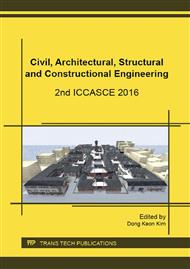p.145
p.151
p.157
p.163
p.173
p.179
p.184
p.190
p.196
Experimental Research on Mechanicals Performance of Carbon Nanotubes Reinforced Concrete
Abstract:
Carbon nanotubes are a promising candidate for the next generation high performance structural and multi-functional composite material due to extremely high aspect ratios and ultra-high strength. It is evident from contemporary researches that utilization of carbon nanotubes in reinforcing cement-based composite materials has a great potential. Industrial carbon nanotubes paste was used for pro-dispersion by ultrasonic and dispersant (PVP) in this study. The mechanical properties of concrete reinforced by carbon nanotubes with different weight percent (0, 0.05, 0.1, 0.15, 0.2, and 0.25 wt. %) were studied in this paper. Test results indicated that the optimal dosage of carbon nanotubes was about 0.22wt. %. Cubic compressive strength and splitting tensile strength were found to be increased by 30.8% and 46.0% in comparison with normal concrete, respectively, while the change of elastic modulus was immaterial. For further analysis, the scanning electron microscope was employed to observe the dispersion of carbon nanotubes in concrete.
Info:
Periodical:
Pages:
173-178
Citation:
Online since:
November 2016
Authors:
Price:
Сopyright:
© 2017 Trans Tech Publications Ltd. All Rights Reserved
Share:
Citation:


